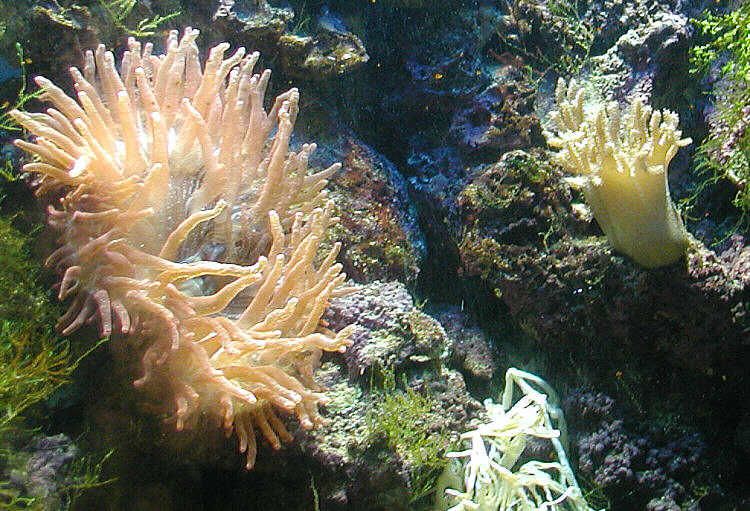Heidelberg Researchers Find Unusually Elastic Protein

Scientists at Heidelberg University and the Heidelberg Institute for Theoretical Studies (HITS) have discovered an unusually elastic protein in one of the most ancient groups of animals, the over 600-million-year-old cnidarians. The protein is a part of the “weapons system” that the cnidarians use: a kind of harpoon launched from their body at extremely high speed. The discovery of the hitherto unknown protein in the freshwater polyp Hydra suggests that the molecular mechanism of elasticity could have originated in the cnidarians and evolved to discharge a deadly weapon. Due to the similarity of the protein’s amino acid sequence to spidroin of spider silk, the researchers from the Centre for Organismal Studies dubbed the elastic protein cnidoin. The results of the research were published in the journal “BMC Biology”.
Elastomeric proteins evolved in a diverse range of animals and often fulfil highly specialised biological functions as the elastin in the pulmonary alveoli of higher vertebrates, the resilin in the wing joints of insects or the spidroin in the threads of spider silk. They give tissues mechanical properties that exceed those of artificial materials. These proteins, known as elastomers, share a common property – structurally disordered, repetitive protein sequences that store energy when a molecule is stretched which then can be used in the form of a movement after release. These movements can be rhythmical, as in the blood vessels leaving the heart. Or they can be single, explosive movements, as in the jump of a grasshopper.
In their experiments on the freshwater polyp Hydra, the research team of Assistant Professor Dr. Suat Özbek and Prof. Dr. Thomas Holstein at the Centre for Organismal Studies (COS) demonstrated that cnidoin is part of the cnidarian weaponry – the stinging capsules. These organelles help jellyfish, corals and sea anemones capture prey and ward off enemies. When touched, a tubule is ejected within nanoseconds in a harpoon-like fashion from the interior of the highly pressurised capsule. The discharge of the stinging thread is one of the fastest processes known in the animal kingdom. Its barbed tip injects poisons through the stinging thread that paralyse or kill the attacker or prey within seconds. “Cnidoin is a structural component of the capsule wall, which is elastically stretched prior to discharge and firing of the harpoon,” explains Dr. Özbek.
Together with other researchers in Heidelberg and Munich, the scientists at COS investigated the biomechanical properties of cnidoin. Force measurements were performed on single molecules and computer simulations conducted. The special properties of the elastic protein are principally responsible for the enormous acceleration of the “harpoon tip” that occurs during the discharge process and, according to Dr. Özbek, exceeds five million g. “The biomechanical properties of cnidoin are comparable to those of other elastomers. However, cnidoin evidences extraordinarily fast recoil, probably due to the extensive cross-linking to the dense capsule wall.”
The researcher points out that the molecular mechanism of elasticity emerged several times in the animal kingdom, independently of each other. “From an evolutionary standpoint, however, cnidoin is oldest elastic protein reported so far,” states Suat Özbek. “We therefore assume that this elasticity originated in the cnidaria and evolved as part of their ‘weapons system’.”
Prof. Dr. Wolfgang Petrich of Heidelberg University’s Kirchhoff Institute for Physics and Prof. Dr. Frauke Gräter and Dr. Davide Mercadante of the Heidelberg Institute for Theoretical Studies (HITS) also participated in the research, along with physicist Dr. Martin Benoit from LMU Munich.
Original publication:
A. Beckmann, S. Xiao, J.P. Müller, D. Mercadante, T. Nüchter, N. Kröger, F. Langhojer, W. Petrich, T.W. Holstein, M. Benoit, F. Gräter and S. Özbek: A Fast Recoiling Silk-like Elastomer Facilitates Nanosecond Nematocyst Discharge, BMC Biology.2015, 13:3 (16 January 2015), doi: 10.1186/s12915-014-0113-1
Press Contact:
Dr. Peter Saueressig
Head of Communication
Heidelberg Institute for Theoretical Studies (HITS)
Phone: +49-6221-533245
Peter.saueressig@h-its.org
www.h-its.org
Twitter: @HITStudies
Scientific Contact:
Privatdozent Dr. Suat Özbek
Centre for Organismal Studies
Telefon (06221) 54-5638
suat.oezbek@cos.uni-heidelberg.de
About HITS
HITS, the Heidelberg Institute for Theoretical Studies, was established in 2010 by physicist and SAP co-founder Klaus Tschira (1940-2015) and the Klaus Tschira Foundation as a private, non-profit research institute. HITS conducts basic research in the natural, mathematical, and computer sciences. Major research directions include complex simulations across scales, making sense of data, and enabling science via computational research. Application areas range from molecular biology to astrophysics. An essential characteristic of the Institute is interdisciplinarity, implemented in numerous cross-group and cross-disciplinary projects. The base funding of HITS is provided by the Klaus Tschira Foundation.
